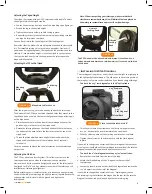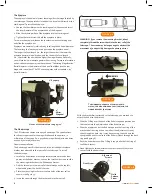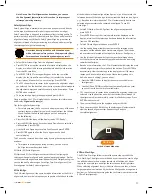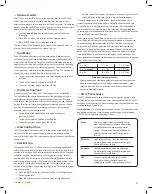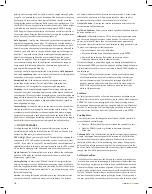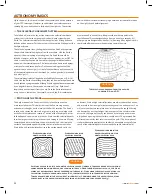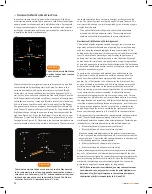
>>
www
.celestron
.com
9
the telescope can create a model of the sky, which it uses to locate any
object with known coordinates. There are many ways to align the CPC
with the sky depending on what information the user is able to provide:
SkyAlign uses the internal GPS receiver to acquire all the necessary time/
site information needed for the CPC to create an accurate model of the
sky . Then the user can simply point the telescope to any three bright
celestial objects to accurately align the telescope with the sky. Auto
Two-Star Align will ask the user to choose and center the first alignment
star, then the CPC will automatically select and slew to a second star
for alignment . Two-Star Alignment requires the user to identify and
manually slew the telescope to the two alignment stars . One-Star Align
is the same as Two-Star Align; however, it only requires you to align
to one known star . Although not as accurate as the other alignment
methods, One-Star Align is the quickest way to find and track bright
planets and objects in Altazimuth mode. Solar System Align will display
a list of visible daytime objects (planets and the Moon) available to align
the telescope. Finally, EQ North and EQ South alignments are designed
to assist you in aligning the CPC when polar aligned using an equatorial
wedge . Each alignment method is discussed in detail below .
“Altazimuth” or “Alt-Az” refers to a type of mounting that allows
a telescope to move in both altitude (up and down) and azimuth
(left and right) with respect to the ground. This is the simplest
form of mounting in which the telescope is attached directly to a
tripod without the use of an equatorial wedge.
SkyAlign
SkyAlign must be used with the telescope mounted in altazimuth . With
SkyAlign, the GPS receiver links with and acquires information from 3 of
the orbiting GPS satellites . With this information, the built-in GPS system
calculates the scope’s location on Earth with an accuracy of a few meters
and calculates universal time down to the second . After quickly making
all these calculations and automatically entering the information for you,
the user simply needs to aim the telescope to any three bright celestial
objects in the sky. Since SkyAlign requires no knowledge of the night sky,
it is not necessary to know the name of the stars that you are aiming at .
You may even select a planet or the Moon . The CPC is then ready to start
finding and tracking any of the objects in its 40,000+ object database.
Before the telescope is ready to be aligned, it should be set up in an
outside location with all accessories (eyepiece, diagonal and finderscope)
attached and lens cover removed as described in the Assembly section of
the manual . To begin SkyAlign:
1. Power on the CPC by flipping the switch located on the control panel
of the drive base to the “on” position. Once turned on, the hand
control display will say CPC Ready . Press ENTER to choose SkyAlign
or use the UP/DOWN scroll keys (10) to select a different method of
alignment. Pressing the ALIGN key will bypass the other alignment
options and the scrolling text and automatically begins Sky Align .
2. Once Sky Align has been selected, the hand control will display “Enter
if OK”, “Undo to Edit” and “GPS Linking”. The bottom line of the LCD
will display either the current time or the time when you last used the
telescope . The GPS will quickly link up and display the current date,
time and location. Additionally, you have the option of pressing UNDO
and manually updating the time/site information . Press ENTER to
accept the time/site information downloaded from the GPS .
3 . The hand control will display a message reminding you to level the
tripod if you already haven’t done so . Press ENTER to continue .
4 . Use the arrow buttons on the hand control to slew (move) the
telescope towards any bright celestial object in the sky. Center the
object in the crosshairs of the finderscope and press ENTER.
5. If the finderscope has been properly aligned with the telescope tube,
the alignment star should now be visible inside the field of view of the
eyepiece . The CPC will ask that you center the bright alignment star
in the center of the eyepiece and press the ALIGN button. This will
accept the star as the first alignment position. (There is no need to
adjust the slewing rate of the motors after each alignment step. The
CPC automatically selects the best slewing rate for aligning objects in
both the finderscope and the eyepiece).
6. For the second alignment object, choose a bright star or planet as far
as possible from the first alignment object. Once again use the arrow
button to center the object in the finderscope and press ENTER. Then
once centered in the eyepiece, press the ALIGN button.
7. Repeat the process for the third alignment star. When the telescope
has been aligned to the final stars, the display will read Match
Confirmed. Press UNDO to display the names of the three bright
objects you aligned to, or press ENTER to accept these three objects
for alignment. You are now ready to find your first object.
A Few Words on GPS:
The CPC uses an on-board GPS to take the guesswork out of
aligning your telescope with the sky. Once an alignment method
is selected, the CPC automatically initiates the internal GPS
module. However, there are a few things you should be aware of
in order to get full use of its many capabilities:
GPS alignment will only work when the telescope is set-up outdoors
with an unobstructed view of the sky. If the CPC is set-up in a location
that has a limited horizon in any direction, it may take longer for the
telescope to find and link with the needed satellites.
When using the GPS for the first time, it may take 3-5 minutes
for the CPC to link-up with its satellites. Once the telescope is
successfully linked, leave the telescope powered on for at least
20 minutes. During this time the CPC will download the complete
almanac of orbital elements (called the ephemeris) for the orbiting
GPS satellites. Once this information is received, it will be stored
for future alignments.
If your CPC is transported over a long
distance (say from the northern to the
southern hemisphere), it may take as long
as one hour to establish a satellite link
from its new location. Observers wishing to
travel long distances with their telescope
are advised to turn on their telescope in
advance to allow the GPS to acquire the necessary data.
Tips for Using SkyAlign
Remember the following alignment guidelines to make using SkyAlign
as simple and accurate as possible .
• Be sure to level the tripod before you begin alignment. The time/
site information along with a level tripod will help the telescope
better predict the available bright stars and planets that are above
the horizon .
• Remember SkyAlign does not care where the optical tube is
pointed at the beginning of the alignment . So to make the
alignment process even faster, it is acceptable to move the
telescope to the first alignment star manually by loosening both
clutches . However the following alignment stars still need to be
found and centered using the hand control .
• Remember to select alignment stars that are as far apart in the sky
as possible. For best results, make sure that the third alignment
star does not lie in a straight line between the first two stars. This
may result in a failed alignment .
Summary of Contents for 11007
Page 1: ...InstructionManual 11007 11008 11009...
Page 2: ...www celestron com...
Page 40: ...38 www celestron com APPENDIXD MAPSOFTIMEZONES...
Page 41: ...www celestron com 39...
Page 42: ...40 www celestron com APPENDIXE SKYMAPS...
Page 43: ...www celestron com 41...
Page 44: ...42 www celestron com...
Page 45: ...www celestron com 43...
Page 46: ...44 www celestron com...
Page 47: ...www celestron com 45...







